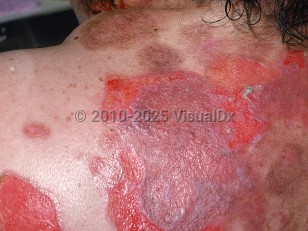Pemphigus vulgaris in Adult
See also in: Anogenital,Oral Mucosal LesionAlerts and Notices
Important News & Links
Synopsis

The estimated incidence worldwide is 0.76-5 cases per million per year, although PV occurs in higher incidences in individuals of Jewish ancestry, as well as in certain geographic areas (Middle East, Southeastern Europe, and India). Variants of the ST18 gene have been found to confer increased risk of PV in some populations. PV is typically a disease of adults, with average onset between the ages of 40 and 60 years, but PV rarely can occur in childhood and young adulthood. There does not appear to be a consistent sex predilection.
Severe cases of PV can be life-threatening, and complications can be related to immunosuppression from drugs used to treat severe PV, secondary infections, loss of the skin barrier, and poor oral intake.
Codes
L10.0 – Pemphigus vulgaris
SNOMEDCT:
49420001 – Pemphigus vulgaris
Look For
Subscription Required
Diagnostic Pearls
Subscription Required
Differential Diagnosis & Pitfalls

Subscription Required
Best Tests
Subscription Required
Management Pearls
Subscription Required
Therapy
Subscription Required
Drug Reaction Data
Subscription Required
References
Subscription Required
Last Updated:01/10/2022
 Patient Information for Pemphigus vulgaris in Adult
Patient Information for Pemphigus vulgaris in Adult- Improve treatment compliance
- Reduce after-hours questions
- Increase patient engagement and satisfaction
- Written in clear, easy-to-understand language. No confusing jargon.
- Available in English and Spanish
- Print out or email directly to your patient


